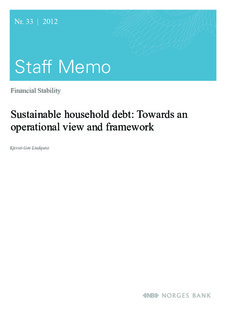| dc.contributor.author | Lindquist, Kjersti-Gro | |
| dc.date.accessioned | 2018-08-01T13:09:33Z | |
| dc.date.available | 2018-08-01T13:09:33Z | |
| dc.date.issued | 2012 | |
| dc.identifier.isbn | 978-82-7553-712-4 | |
| dc.identifier.issn | 1504-2596 | |
| dc.identifier.uri | http://hdl.handle.net/11250/2507168 | |
| dc.description.abstract | From a broad financial stability perspective, sustainable household debt should be evaluated within a steady-state consumption-path approach. We calculate measures for households’ steady-state consumption based on average consumption to income ratios for a number of household groups and use a ‘counterfactual history approach’ to evaluate their debt sustainability. The results show that households within the first-home buyers and second steppers groups, which hold more than half of total household debt in Norway, are vulnerable to an increase in the loan rate. | nb_NO |
| dc.language.iso | eng | nb_NO |
| dc.publisher | Norges Bank | nb_NO |
| dc.relation.ispartofseries | Staff Memo;33/2012 | |
| dc.rights | Attribution-NonCommercial-NoDerivatives 4.0 Internasjonal | * |
| dc.rights.uri | http://creativecommons.org/licenses/by-nc-nd/4.0/deed.no | * |
| dc.subject | household debt | nb_NO |
| dc.subject | sustainability | nb_NO |
| dc.subject | consumption | nb_NO |
| dc.title | Sustainable Household Debt : Towards an Operational View and Framework | nb_NO |
| dc.type | Working paper | nb_NO |
| dc.subject.nsi | VDP::Samfunnsvitenskap: 200::Økonomi: 210 | nb_NO |
| dc.source.pagenumber | 35 | nb_NO |

